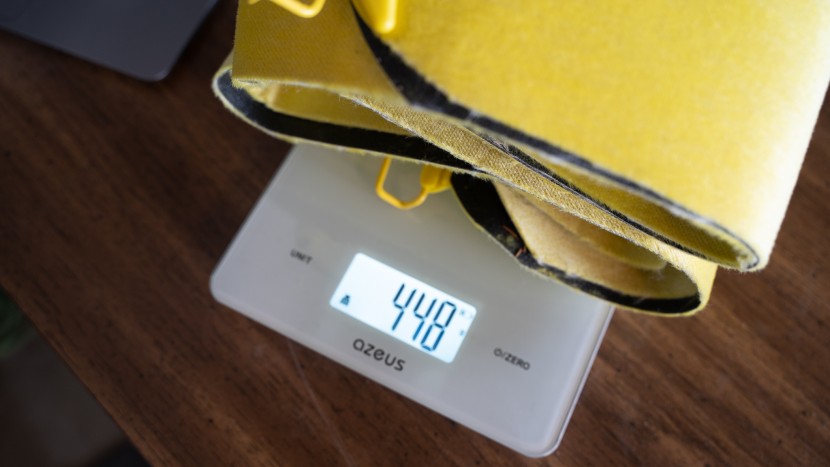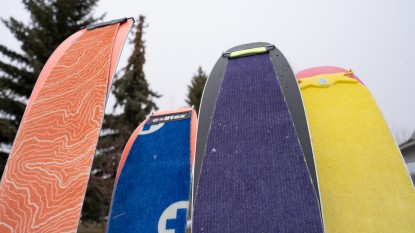
Our Verdict
Our Analysis and Test Results
Product Update — November, 2024
Pomoca is slowly phasing out their Climb line of skins, including the Climb 2.0 we tested for this review. It will be replaced by the Tour Explore, which includes a number of meaningful updates including new tip and tail clips, and Pomoca's new Ever Dry 3.0, a PFC-free hydrophobic treatment. It will be a gradual process, and we will link continue to link to the Climb 2.0 as long as it remains available.
Climb 2.0 skins ("you know, the yellow ones") are Pomoca's budget offering. They use the same top shelf materials and design as their other skins, but save you dollars by skipping a glide-optimizing treatment. They make these in a huge array of sizes, price them competitively and have made them reasonably widely available.
Glide
Pomoca's nylon/mohair blend is legendary for well balanced performance. As best anyone can tell, the fabric of the Climb 2.0 is the same as that used on the more premium Pomoca offerings. This is a good thing. Tens of thousands of skiers have racked up millions (billions?) of vertical feet on this exact fabric, all the while appreciating the easy sliding nature during each stride.
As noted above, Pomoca hit the budget price point with the Climb 2.0 by omitting their “S-Glide” treatment. Their more expensive skins get the treatment. We can't say for sure, but it sure seems that that treatment wears off. Our test team couldn't tell the difference between the Climb 2.0 and older mohair/nylon skins that originally came with the treatment. If you are hunting for a deal you will probably also keep your skins longer than the factory glide treatment will last. At least some of your use of any Pomoca skins will be well after any treatment would have worn off anyway. The Climb 2.0 glides great, even without the spendy treatment.
Portability
These flashy yellow skins pack down pretty darn small and, in our rudimentary weight comparison, come out near the top of the charts. Our lead tester chose exactly these skins for a three week Denali expedition. An expedition like that is heavy enough “as is”. Selecting lightweight gear enhances the experience.
It is difficult to directly compare bulk and weight of climbing skins. We do our testing of skins on our entire fleet of tester backcountry skis. The result is that most of our skins are cut for different sizes and shapes of skis. That said, we can make some rudimentary, and pretty reliable, comparisons. Many of our tester skis are in the same, middle size range. We cut the Climb 2.0 for 180cm x 99mm skis. This is certainly the meaty center of the tested bell curve. Of all the skins cut for skis of this size, the Pomoca Climb 2.0 is among the lightest.
Glue Integrity
Pomoca glue works, when it works. It is not flashy. It is not the strongest nor is it the easiest to get to release from your skis. It strikes a balance. The inherently balanced nature of all climbing skin attributes makes writing reviews of them decidedly vague and difficult. No attribute of a climbing skin could ever be “maxed out”. The strongest glue wouldn't work. Skin glue will always need to strike a balance. Recent years have seen highly variable performance from Pomoca skin glue, including on our tested samples. Rumors spread of a container load that got too warm in transit in the early pandemic era. Whatever happened, we lost some confidence in the reliability of Pomoca glue in the process. If you are on a budget, you also don't want to burn up time and mental bandwidth working out whether the skins you buy are the good ones or from the rumored bad batch. That said, the last couple of ski seasons have seen far more reliable performance from Pomoca glue on new skins.
Skin glue will also always degrade and accumulate junk. If it is to work it must be sticky. If it is sticky it will pick up detritus, snow, ice, and water. These are foundational truths. You will find scores of online reviews condemning every single type of skin for “glue failure”. All skin glue fails, somehow. Whether on one tour and they need to be dried out at home, or over weeks and months of use and in such a way that they require cleaning or regluing. The trick is in making it last and performing suitable maintenance. Pomoca skins work for dozens, if not hundreds, of days before requiring robust maintenance. We've found this with almost a dozen different tester Pomoca products, most of which have the same glue formulation.
Grip
All we really need skins for is traction or grip. It would seem, then, that “more is better”. But it is not that simple. More and more grip means more and more stride friction. Just like every other skin attribute, grip and glide must be balanced. Again, the Climb 2.0 has just enough grip. They are definitely not the grippiest skins on the market.
On the aforementioned Denali expedition the Climb 2.0 provided enough traction for a “single carry” camp move with 125 pounds of gear split between a huge backpack and a sled. On that same expedition we skinned blue ice and steep switchbacks (thankfully, as the skinning got trickier the loads got lighter.). Through it all the Climb 2.0 had all the traction that an expert skinner needed. In more pedestrian backcountry settings beginners and intermediate backcountry skiers will have all the grip they need.
Icing and Glopping Resistance
Icing and glopping most commonly and stubbornly occurs when the fabric fibers absorb liquid water and then picks up cold, dry snow to refreeze. Subsequent cycles of this can aggregate more and more ice/snow into and onto your skins. The only thing that your skins can “do” to prevent icing is to not soak up water in the first place. Material and waterproof treatment choices are the “levers” that a manufacturer can pull to enhance icing resistance. Whatever Pomoca is doing is working. They claim a proprietary water resistant coating and we know that the fabric is a blend of mohair (good gliding, more water absorption) and nylon (less water absorption). The end result is satisfactory glopping resistance.
It is possible that the solid, light color of the Pomoca Climb 2.0 makes them marginally better at resisting glopping. Light colors absorb less sunshine than dark colors. Less sunshine means less warming. Less warming means less liquid water in the fabric. If this has any affect for the Climb 2.0 it is minimal. But it also a low- to zero-cost move. There is no drawback we can think of to the yellow color of these skins.
Compatibility
You can buy the Pomoca Climb 2.0 in many different sizes. The tip loops are interchangeable depending on your ski tip radius. The tail strap and clip are widely compatible, even with very rounded profiles. The Climb 2.0 is widely compatible. Given all the sizing purchase options they are beat for maximum compatibility only by those makes and models that feature metal hooks at the tip.
Pomocas latest tail clip is too narrow to easily work on most skis. It can be stretched out, temporarily, to work through a day's tour. It then shrinks back down and needs to be stretched again the next time you wish to use them.
Should You Buy the Pomoca Climb 2.0?
The Climb 2.0 are an affordable, proven pair of skins that are well-worth the investment for any skier. That's been well verified by their recent popularity at backcountry-skiing trailheads everywhere — you'll see these yellow skins all over the hills.
What Other Climbing Skins Should You Consider?
The “fancier” version of these skins, the Pomoca Climb Pro S Glide takes a top spot in this review. The Climb Pro S Glide delivers marginally better performance and only costs a few bucks more. It's well-worth considering the extra investment. The timeless Black Diamond Glidelite Mix FL also present a fantastic value based on their durability and longevity, particularly related to their glue integrity. The Big Sky Mountain Products Mohair Mix Endurance is even less expensive, but doesn't perform quite as well as the Pomocas.
| Awards | Best Bang for the Buck |
|---|---|
| Price | $200 List Check Amazon (on sale!) |
Overall Score  |
|
| Star Rating | |
| Bottom Line | Budget friendly high performance skins for every backcountry skier |
| Pros | All around performance, huge size range available |
| Cons | Compromised glide when new, more prone to icing than more expensive alternatives |
| Rating Categories | Pomoca Climb 2.0 |
| Glide (30%) | |
| Portability (20%) | |
| Glue Integrity (20%) | |
| Grip (15%) | |
| Icing and Glopping Resistance (10%) | |
| Compatibility (5%) | |
| Specifications | Pomoca Climb 2.0 |
| Measured Weight (lbs per pair) | 0.99 |
| Material | 70% Mohair, 30% Nylon |
| Weight per Pair (Based on Ski Tested) | 448 g for Dynastar M99 Tour, 178 cm |
| Weight per Ski Width (grams/mm) | 2.25 |
| Glue | Traditional |
| Tip Attachment | Rigid tip loop |
| Tail Attachment | Rubber strap and cam hook |
| Ski Compatibility | Universal |












